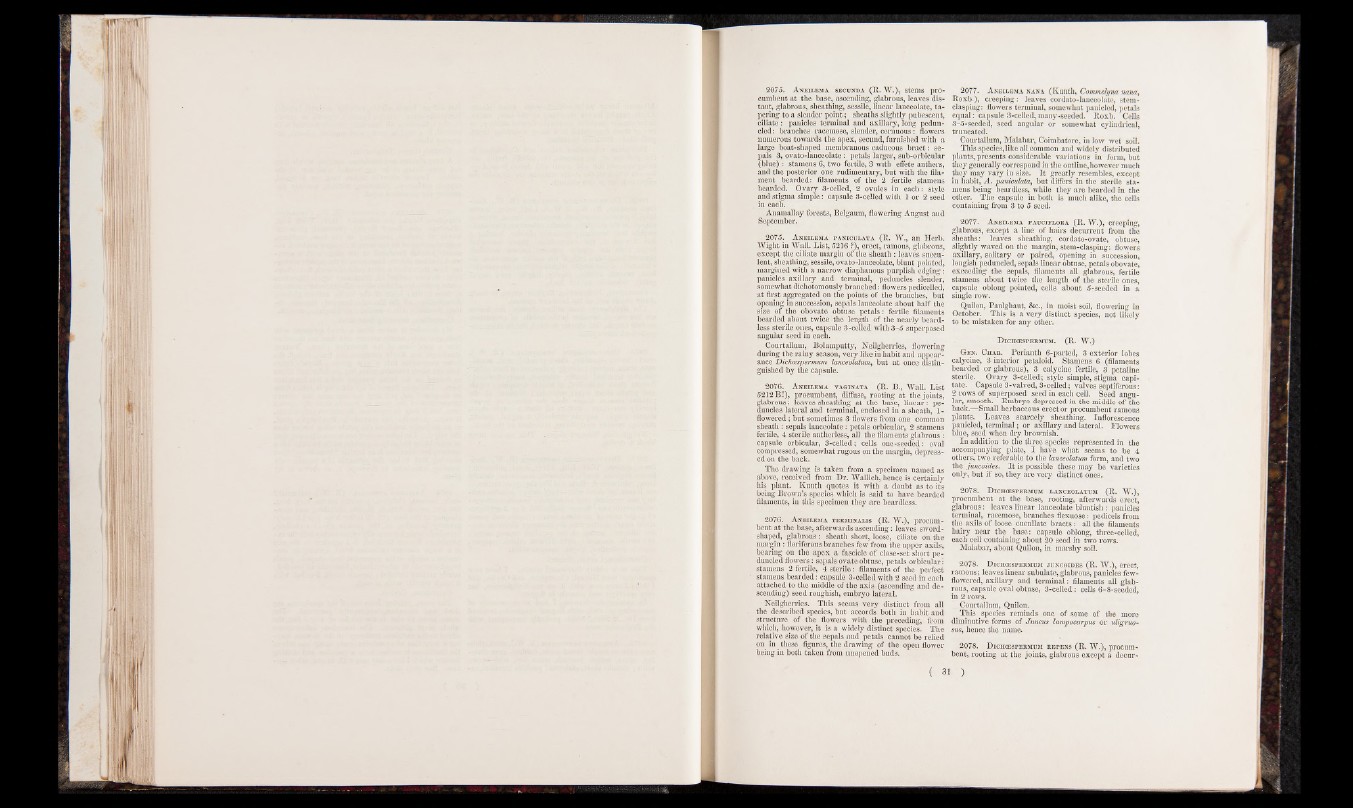
2075. Aneilema secunda (R. W.), stems procumbent
at the base, ascending, glabrous, leaves distant,
glabrous, sheathing, sessile, linear lanceolate, tapering
to a slender point; sheaths slightly pubescent,
ciliate: panicles terminal and axillary, long pedun-
cled: branches racemose, slender, cernuous: flowers
numerous towards the apex, secund, furnished with a
large boat-shaped membranous caducous b ra c t: sepals
3, ovato-lanceolate: petals larger, sub-orbicular
(blue) : stamens 6, two fertile, 3 with effete anthers,
and the posterior one rudimentary, but with the filament
bearded: filaments of the 2 fertile stamens
bearded. Ovary 3-celled, 2 ovules in each: style
and stigma simple: capsule 3-celled with 1 or 2 seed
in each.
Anamallay forests, Belgaum, flowering August and
September.
2075. Aneilema paniculata (R. W., an Herb.
Wight in Wall. List, 5216 ?), erect, ramons, glabrous,
except the ciliate margin of the sheath : leaves succulent,
sheathing, sessile, ovato -lanceolate, blunt pointed,
margined with a narrow diaphanous purplish edging:
panicles axillary and terminal, peduncles slender,
somewhat dichotomously branched: flowers pedicelled,
a t first aggregated on the points of the brauches, but
opening in succession, sepals lanceolate about half the
size of the obovate obtuse petals: fertile filaments
bearded about twice the length of the nearly beardless
sterile ones, capsule 3-celled with 3-5 superposed
angular seed in each.
Courtallum, Bolamputty, Neilgherries, flowering
during the rainy season, very like in habit and appearance
Dichcespermum lanceolatum, but at once distinguished
by the capsule.
2076. A neilema vaginata (R. B., Wall. List
5212 B!), procumbent, diffuse, rooting at the joints,
glabrous: leaves sheathing at the base, linear: peduncles
lateral and terminal, enclosed in a sheath, 1 -
flowered; but sometimes 3 flowers from one common
sheath: sepals lanceolate: petals orbicular, 2 stamens
fertile, 4 sterile antherless, all the filaments glabrous:
capsule orbicular, 3-celled; cells one-seeded: oval
compressed, somewhat rugous on the margin, depressed
on the back.
The drawing is taken from a specimen named as
above, received from Dr. Wallich, hence is certainly
his plant. Kunth quotes it with a doubt as to its
being Brown’s species which is said to have bearded
filaments, in this specimen they are beardless.
2076. Aneilema tekminalis (R. W.), procumbent
at the base, afterwards ascending: leaves swordshaped,
glabrous : sheath short, loose, ciliate on the
margin : floriferous branches few from the upper axils,
bearing on the apex a fascicle of close-set short pe-
duncled flowers: sepals ovate obtuse, petals orbicular !
stamens 2 fertile, 4 sterile: filaments of the perfect
stamens bearded: capsule 3-celled with 2 seed in each
attached to the middle of the axis (ascending and descending)
seed roughish, embryo lateral.
Neilgherries. This seems very distinct from all
the described species, but accords both in habit and
structure of the flowers with the preceding, from
which, however, it is a widely distinct species. The
relative size of the sepals and petals cannot be relied
on in these figures, the drawing of the open flower
being in both taken from unopened buds.
2077. Aneilema nana (Kunth, Commelyna nana,
Roxb.), creeping: leaves cordato-lanceolate, stem-
clasping: flowers terminal, somewhat panicled, petals
equal: capsule 3-celled, many-seeded. Roxb. Cells
3-5-seeded, seed angular or somewhat cylindrical,
truncated.
Courtallum, Malabar, Coimbatore, in low wet soil.
This species,like all common and widely distributed
plants, presents considerable variations in form, but
they generally correspond in the outline, however much
they may vary in size. I t greatly resembles, except
in habit, A. paniculata, but differs in the sterile stamens
being beardless, while they are bearded in the
other. The capsule in both is much alike, the cells
containing from 3 to 5 seed.
2077. Aneilema pauciflora (R. W.), creeping,
glabrous, except a line of hairs decurrent from the
sheaths: leaves sheathing, cordato-ovate, obtuse,
slightly waved on the margin, stem-clasping: flowers
axillary, solitary or paired, opening in succession,
longish peduncled, sepals linear obtuse, petals obovate,
exceeding the sepals, filaments all glabrous, fertile
stamens about twice the length of the sterile ones,
capsule oblong pointed, cells about 5-seeded in a
single row.
Quilon, Paulghaut, &c., in moist soil, flowering in
October. This is a very distinct species, not likely
to be mistaken for any other.
D ichcespermum. (R. W.)
Gen. Char. Perianth 6-parted, 3 exterior lobes
calycine, 3 interior petaloid. Stamens 6 (filaments
bearded or glabrous), 3 calycine fertile, 3 petaline
sterile. Ovary 3-celled; style simple, stigma capitate.
Capsule 3-valved, 3-celled; valves septiferous:
2 rows of superposed seed in each cell. Seed angular,
smooth. Embryo depressed in the middle of the
back.—Small herbaceous erector procumbent ramous
plants. Leaves scarcely sheathing. Inflorescence
panicled, terminal; or axillary and lateral. Flowers
blue, seed when dry brownish.
In addition to the three species represented in the
accompanying plate, I have what seems to be 4
others, two referable to the lanceolatum form, and two
the juncoides. I t is possible these may be varieties
only, but if so, they are very distinct ones.
2078. D ichcespermum lanceolatum (R. W.),
procumbent at the base, rooting, afterwards erect,
glabrous: leaves linear lanceolate bluntish: panicles
terminal, racemose, branches flexuose: pedicels from
the axils of loose eucullate bra cts: all the filaments
hairy near the base: capsule oblong, three-celled,
each cell containing about 20 seed in two rows.
Malabar, about Quilon, in marshy soil.
2078. D ichcespermum juncoides (R. W .), erect,
ramous; leaves linear subulate, glabrous, panicles few-
flowered, axillary and terminal: filaments all glabrous,
capsule oval obtuse, 3-celled: cells 6- 8-seeded,
in 2 rows.
Courtallum, Quilon.
This species reminds one of some of the more
diminutive forms of Juncus lampocarpus or idigruo-
sus} hence the name.
2078. D ichcespermum repens (R. W.), procumbent,
rooting at the joints, glabrous except a decur-
1 31 fl